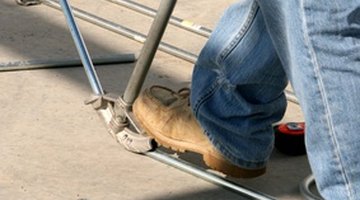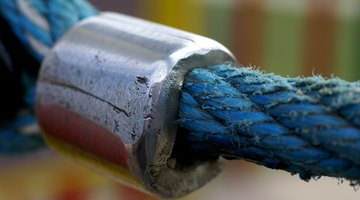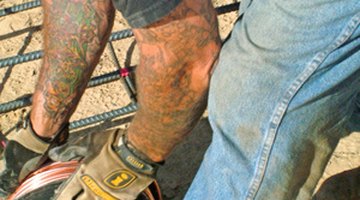How to Best Connect Wire to a Rope for Pulling
Almost all electrical work in commercial and industrial buildings includes electrical conduit. A conduit raceway contains the wiring for one or many circuits. In a three-phase circuit, just one circuit contains up to four wires. In a single run of conduit, you might have as many as nine No. 12 wires in a 1/2-inch conduit. A large amperage circuit still has three to four wires in a single conduit. These three or four wires are much larger than others. Some can be as big or bigger than a broomstick, making them very hard to bend and handle.

Step 1

Verify that the pull rope is large enough for the wires you pull. Rope size depends on conduit size. A good rule of thumb is to use 1/4 inch for every 1 inch of conduit, such as 1-inch diameter rope for a 4-inch conduit.
Step 2

Make a loop. If you use large conduit, 1 1/4 inch or larger, use a bowline to make a loop. If the conduit is from 1/2 to 1 inch, consider using a metal clevis. To make a permanent loop or for all conduit sizes, it's better to whip a loop in the end of the rope.
Step 3

Strip enough insulation from each conductor to make a suitable hook. For No. 12, make it at least 6 inches. For 4/0, make it about 24 inches.
Step 4

Divide all the strands of each conductor into two equal sections. Bend 1/2 of the strands back along the conductor, leaving 1/2 of the strands sticking straight out. Cut off the straight strands close to the insulation. Then bend the bent wires so they are straight. This keeps all the strands straight with no barbs to snag the walls of the conduit.
Step 5

Form a hook using the bare strands of each conductor so the end just touches the part where the insulation starts. Do all conductors exactly the same way. The result should be a hook that is the same diameter as the wire.
Step 6
Attach the hooked wired to the rope. Begin by gathering all the hooked wires around the rope loop. Tape the bare copper wire hooks and the rope loop into a single long length. The bundle of wires and the rope should look like a straight black tube with no bulges.
References
- National Electrical Code: Article 310.16
- National Electrical Code: Article 300
- National Electrical Code: Annex C
Writer Bio
Frank Bingham started writing in 2010. A veteran of the electrical field since 1969, he worked for a small wholesale electrical supplier, moving his way up from delivery to counter manager to outside sales. Frank started his own company specializing in small industrial and commercial electrical installations. After retirement he became an instructor on the National Electrical Code, at a local trade school.
Photo Credits
- electrician,electrical, image by Greg Pickens from Fotolia.com
- rope image by Tomasz Plawski from Fotolia.com
- bowline knot image by Rog999 from Fotolia.com
- electrical image by Greg Pickens from Fotolia.com
- hook image by Zbigniew Nowak from Fotolia.com
- The sailor image by Hunta from Fotolia.com
More Articles



